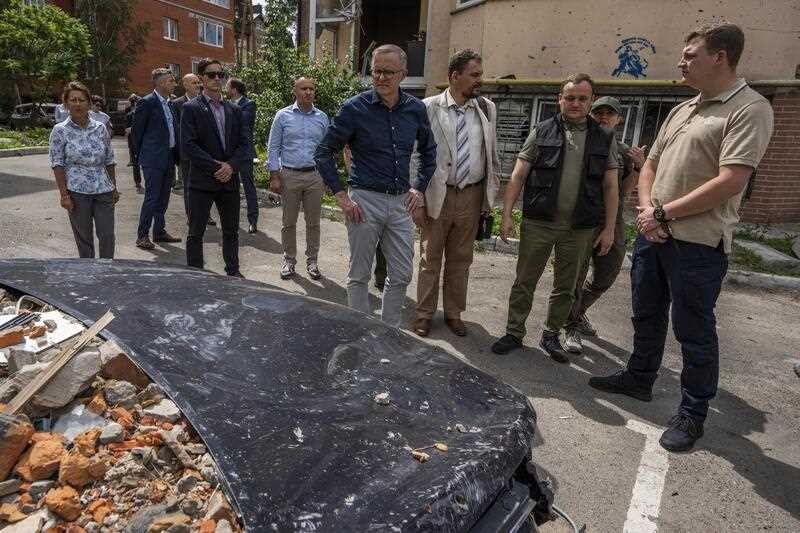When the Russian invasion of Ukraine started on February 24, Australian embassy staffer Nadia Teriokhina had one thought – she didn’t want to get trapped behind enemy lines.
She told Prime Minister Anthony Albanese she counted herself among the lucky ones.
Hundreds were massacred in Bucha outside of Kyiv, and about 10 minutes from her home in Irpin, including women and children. Some women were raped before they were killed.
“We didn’t know what to do, how to behave or where to run,” she said on Sunday.
“I said to my husband, ‘I just don’t want to be in the occupied territory’ so we went to Kyiv.”
Ukrainian tanks were headed in the opposite direction as they fled to the capital.
The executive assistant embraced her boss, Australian Ambassador Bruce Edwards, when they reunited at the weekend outside what was left of her apartment block.
Both are waiting for the Australian embassy to reopen in Kyiv so they can can restart work.
Ms Teriokhina’s own flat was undamaged but the building was condemned as unsafe.
“I had somewhere to stay, in Kyiv right now. But some of my neighbours, especially the elderly people, have nowhere to go,” she said.
Mr Albanese travelled to Ukraine in a party including three members of the media amid very tight security. At least a dozen armed Australian Special Forces soldiers were on the ground to assist.
The party’s vehicle convoy carried weapons, body armour and medical provisions in case of an emergency.
Ukrainian special forces, in full battle kit, also shadowed the prime minister’s every move.
Mr Albanese travelled first to Bucha, to pay his respects at a mass grave where 416 civilians were buried by Russian forces after being executed.
“Bucha is now a notorious name,” local council head Tars Shaprovskiy told him.
“This is a very sad place.
“Every one of them shot. This was not collateral damage, this was intentional.
“One of the slaughter houses was a summer camp. There were four volunteers there. They were all shot.”
Mr Albanese told him: “Australia shares your desire to seek justice for these war crimes, and we will continue to do so”.
The grave, behind the town’s Church of St Andrews, has become a pilgrimage site for visiting dignitaries.
In a chapel underneath the church, Mr Albanese joined the congregation, lighting a candle for the victims of the massacre.
Mr Albanese travelled in an armoured LandCruiser. Local traffic was blocked wherever his party went, with soldiers and police stationed along the route.
Central Kyiv appeared largely undamaged to the visitors, but concrete blocks and sandbags protect major buildings, and large welded steel road spikes sit at the sides of key routes into the city, ready to be deployed if the invaders try and attack the city again.
Some shops and hotels have reopened. There was even a small group of tourists milling around near the Intercontinental Hotel, which Mr Albanese’s team used as a base during the visit.
But 30 minutes north of the city, signs of war are obvious – blown out buildings, missile craters, broken windows, piled-up wrecks of burned out cars and sandbagged foxholes under the cover of trees.
Ahead of his meeting with President Volodymyr Zelenskiy on Sunday afternoon, Mr Albanese visited the destroyed Hostomel Airport, the site of a failed Russian paratrooper assault in the initial days of the invasion aimed at securing the facility to surge in troops and supplies by air.
He shook his head as he surveyed the wreckage of the what was once the world’s largest aircraft, the Antonov Mriya, which translates to “The Dream”.
He spoke to members of the national guard unit that faced a determined attack by Russian forces to land helicopters at the airfield, which could have changed the course of the war.
As he left, they gave him a model of the famous Antonov plane.
Mr Albanese said as a former aviation minister, he was touched by the gesture, and the model would take “pride of place” in his prime ministerial office.
Ukraine’s Ambassador to Australia, Vasyl Myroshnychenko, travelled to Kyiv for the visit after earlier extending an invitation to Mr Albanese on behalf of the president.
An advance security team comprising 2nd Commando and Special Air Service Regiment personnel was deployed to the country to work with the Ukraine Defence Force and the Australian embassy – now based temporarily in Poland – to make the visit happen.
A member of the team said the capital was mostly safe. The main risk was a potential missile strike.
Russia has recently upped its use of rockets against targets across the country in retaliation for Ukraine’s use of American-donated high mobility artillery rocket system missiles.
Ukraine’s Deputy Foreign Affairs Minister Mykola Tochytskyi said things were “much more difficult in the east”, where Ukrainian forces are being pounded relentlessly by Russian artillery.
“If you look at the quantity of her artillery, it is one to seven (to Russia),” he said.
“That’s why we appreciate Australia’s support, in Bushmaster (protected vehicles), and M777 artillery. They are very effective.”
The trip was made under a strict media blackout imposed by the prime minister’s office on the advice of the Australian Defence Force.
But his presence in the country was revealed on social media, as he travelled around the Ukrainian capital, and its surrounds.
Mr Albanese also met the Australian embassy’s driver, Oleksander Lazarachuk, who fled the fighting in February with his elderly mother, taking her 400km to Lutsk, in the country’s west.
“She didn’t want to leave, but I just took her and off we went,” he said.
Mr Lazarachuk had mixed about meeting Mr Albanese, who was being driven by his special forces team.
“I should be driving you today,” he said. “I am the embassy driver.”
Get local, national and world news, plus sport, entertainment, lifestyle, competitions and more delivered straight to your inbox with the Canberra Daily Daily Newsletter. Sign up here.



